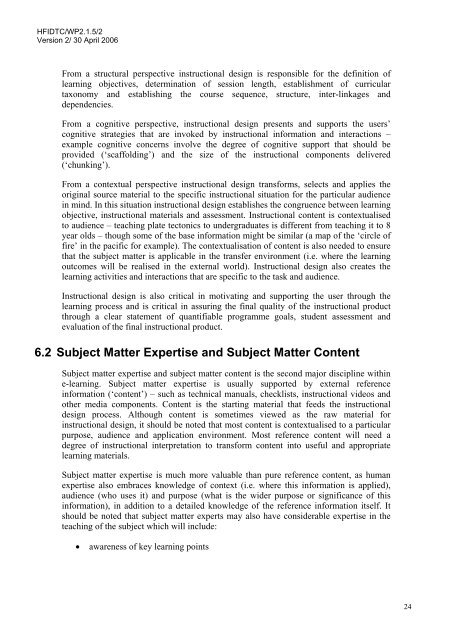E-learning Instructional Design Guidelines - Human Factors ...
E-learning Instructional Design Guidelines - Human Factors ...
E-learning Instructional Design Guidelines - Human Factors ...
Create successful ePaper yourself
Turn your PDF publications into a flip-book with our unique Google optimized e-Paper software.
HFIDTC/WP2.1.5/2<br />
Version 2/ 30 April 2006<br />
From a structural perspective instructional design is responsible for the definition of<br />
<strong>learning</strong> objectives, determination of session length, establishment of curricular<br />
taxonomy and establishing the course sequence, structure, inter-linkages and<br />
dependencies.<br />
From a cognitive perspective, instructional design presents and supports the users’<br />
cognitive strategies that are invoked by instructional information and interactions –<br />
example cognitive concerns involve the degree of cognitive support that should be<br />
provided (‘scaffolding’) and the size of the instructional components delivered<br />
(‘chunking’).<br />
From a contextual perspective instructional design transforms, selects and applies the<br />
original source material to the specific instructional situation for the particular audience<br />
in mind. In this situation instructional design establishes the congruence between <strong>learning</strong><br />
objective, instructional materials and assessment. <strong>Instructional</strong> content is contextualised<br />
to audience – teaching plate tectonics to undergraduates is different from teaching it to 8<br />
year olds – though some of the base information might be similar (a map of the ‘circle of<br />
fire’ in the pacific for example). The contextualisation of content is also needed to ensure<br />
that the subject matter is applicable in the transfer environment (i.e. where the <strong>learning</strong><br />
outcomes will be realised in the external world). <strong>Instructional</strong> design also creates the<br />
<strong>learning</strong> activities and interactions that are specific to the task and audience.<br />
<strong>Instructional</strong> design is also critical in motivating and supporting the user through the<br />
<strong>learning</strong> process and is critical in assuring the final quality of the instructional product<br />
through a clear statement of quantifiable programme goals, student assessment and<br />
evaluation of the final instructional product.<br />
6.2 Subject Matter Expertise and Subject Matter Content<br />
Subject matter expertise and subject matter content is the second major discipline within<br />
e-<strong>learning</strong>. Subject matter expertise is usually supported by external reference<br />
information (‘content’) – such as technical manuals, checklists, instructional videos and<br />
other media components. Content is the starting material that feeds the instructional<br />
design process. Although content is sometimes viewed as the raw material for<br />
instructional design, it should be noted that most content is contextualised to a particular<br />
purpose, audience and application environment. Most reference content will need a<br />
degree of instructional interpretation to transform content into useful and appropriate<br />
<strong>learning</strong> materials.<br />
Subject matter expertise is much more valuable than pure reference content, as human<br />
expertise also embraces knowledge of context (i.e. where this information is applied),<br />
audience (who uses it) and purpose (what is the wider purpose or significance of this<br />
information), in addition to a detailed knowledge of the reference information itself. It<br />
should be noted that subject matter experts may also have considerable expertise in the<br />
teaching of the subject which will include:<br />
• awareness of key <strong>learning</strong> points<br />
24
















